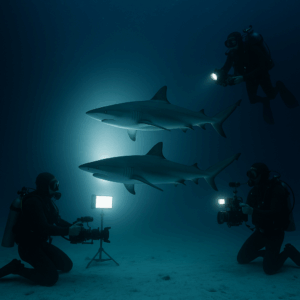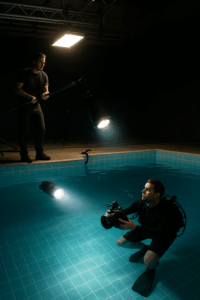Introduction
Underwater cinematography presents a unique set of challenges for filmmakers. The murky depths of water absorb light, distort colors, and limit visibility. The wrong lighting can result in flat, unattractive footage that fails to capture the vibrancy and beauty of the underwater world. However, with the right lighting tools, cinematographers can transform these challenges into opportunities for creative expression.
In this article, we’ll explore how the 2000W RGB+White LED light fixture can help filmmakers achieve superior underwater lighting. This powerful, versatile tool can illuminate the depths with precision, giving directors and cinematographers full control over color temperature and intensity. Let’s dive into how you can use this cutting-edge lighting solution to light your next underwater scene.
- Understanding the Basics of Underwater Lighting
Underwater lighting differs significantly from above-water lighting. The properties of water—its density, salinity, and turbidity—affect how light behaves. As light travels through water, it loses intensity and color. Red wavelengths are absorbed quickly, followed by orange, yellow, and green. By the time light reaches deeper depths, only the blue wavelengths remain, which often results in the iconic blue or greenish tint of underwater shots.
To counter these natural effects, underwater filmmakers must carefully select lighting solutions that provide the necessary intensity and color control. Without the proper lighting, colors can appear washed out, and details can be lost in the darkness. Furthermore, underwater light sources must be specially designed to withstand water pressure and prevent short-circuiting or corrosion.
This is where the 2000W RGB+White LED shines. With its waterproof design and adjustable light settings, this fixture can handle the challenges posed by underwater filming, delivering vibrant, true-to-life colors even in deep or murky waters.
- Why Choose RGB+White LED for Underwater Filming
RGB+White LED technology combines two powerful elements: the RGB (Red, Green, Blue) spectrum and adjustable white light. This hybrid approach allows for both creative flexibility and color accuracy—key factors when it comes to underwater cinematography.
- Color Control: RGB channels offer filmmakers the ability to adjust the lighting’s hue to suit any underwater scene. Whether you’re trying to create a warm, sunlit feel or an eerie, cold environment, RGB LEDs can meet your needs.
- Color Temperature Flexibility: The white LED component can be adjusted to emit a wide range of color temperatures, from warm (2700K) to cool (6500K). This ability to fine-tune the light’s warmth or coolness helps filmmakers compensate for the natural color loss that occurs underwater, providing the flexibility to replicate natural daylight or create dramatic effects.
- CRI and TLCI: The Color Rendering Index (CRI) and Television Lighting Consistency Index (TLCI) are essential metrics for evaluating how accurately a light source displays colors. The 2000W RGB+White LED is engineered with a high CRI (typically above 90) and TLCI, ensuring that your footage will reflect colors as they appear in real life, even under water.
By combining these features, the RGB+White LED allows for precise control over both the color spectrum and the quality of light, giving cinematographers the power to create stunning, lifelike underwater shots.
- Key Features of the 2000W RGB+White LED
The 2000W RGB+White LED is packed with powerful features designed specifically for underwater use. Here are some of its standout specifications:
- High Power Output (2000W): The 2000W output ensures that the LED can provide ample illumination, even at greater depths. This power level is crucial for overcoming the natural light attenuation in water and ensuring that the scene is adequately lit.
- Waterproof Design (IP68): This LED light comes with an IP68 waterproof rating, meaning it can operate underwater without issue. The robust housing protects the internal components from corrosion, ensuring long-lasting performance in harsh conditions.
- Adjustable Color Temperature (2700K-6500K): Whether you need a warm, soft light for close-up shots or a cooler, more neutral tone for wide shots, the ability to adjust color temperature provides flexibility for various creative applications.
- CRI and TLCI Ratings: With high CRI and TLCI ratings, this LED fixture offers exceptional color fidelity, helping ensure that your underwater scenes appear true to life. This is particularly important when shooting subjects like coral reefs or fish, where accurate color reproduction is essential.
- Customizable Light Modes: In addition to standard lighting, the 2000W RGB+White LED supports various modes, such as strobe, fade, and pulse. These effects can add dynamic elements to your underwater scenes, perfect for action sequences or atmospheric shots.

- Planning Your Underwater Lighting Setup
Before submerging your lighting equipment, it’s essential to plan your underwater lighting setup. The key to creating beautiful underwater visuals lies in balancing intensity, positioning, and color.
- Optimal Placement: When positioning the 2000W RGB+White LED, you must consider factors like light direction and diffusion. Typically, underwater lighting should be placed at an angle to reduce shadows and create an even distribution of light. Multiple lights may be necessary for large scenes or wide shots to ensure full coverage.
- Managing Light Falloff: As light travels through water, it diminishes in intensity the further it travels. This falloff is particularly noticeable in deep water or murky conditions. Use your light’s dimming features to adjust the intensity as needed. Experimenting with distance from the subject can also help you control how much light hits the scene.
- Creating Depth: One of the most powerful tools in underwater cinematography is the ability to create depth with light and shadow. By positioning lights at varying angles, you can create contrast, highlight textures, and add a sense of three-dimensionality to the scene. Using multiple RGB+White LEDs at different angles also allows you to highlight specific elements in the environment, such as coral formations or submerged objects.
- Setting the Correct Color Temperature
When shooting underwater, the light you’re using must compensate for the loss of certain wavelengths in the water. Without adjusting the color temperature, underwater shots can easily appear blue or green, which may not reflect the intended mood or aesthetic.
- Neutralizing Blue/Green Tint: To counter the blue/green tint, you can adjust the color temperature to a warmer setting (around 5000K-6500K), which will help balance out the cool hues in the water and bring more natural colors to the foreground. This setting is ideal for simulating daylight conditions underwater.
- Creative Effects: Alternatively, a cooler color temperature can evoke a colder, more mysterious atmosphere, perfect for deep-sea shots or dramatic underwater environments. RGB settings can further enhance this effect by adding colored light to simulate magical or otherworldly conditions.
By fine-tuning the color temperature of the 2000W RGB+White LED, you can tailor the lighting to suit the scene’s requirements, ensuring that the visuals are consistent with your creative vision.
- Managing Light Intensity and Spread
Controlling light intensity and beam spread is vital when working underwater. Too much light can cause overexposure, while too little can result in underexposed, grainy footage.
- Dimming Controls: The 2000W RGB+White LED comes with adjustable dimming functions, allowing you to fine-tune the light output to suit your scene. If you’re working in shallow water, you can lower the intensity to prevent overexposure, while in deeper waters, you can boost the output to ensure visibility.
- Beam Angle and Diffusion: Adjusting the beam angle allows you to control how wide or narrow the light spreads. A wide beam is ideal for illuminating large areas, while a narrow beam is better suited for focusing on specific subjects or creating dramatic effects. Adding diffusers can help soften the light and reduce harsh shadows, giving your scene a more natural look.

- Special Effects with RGB Channels
One of the biggest advantages of using RGB+White LEDs in underwater cinematography is the ability to create unique lighting effects. The RGB channels enable you to manipulate colors, adding a layer of creativity to your shots.
- Mood Lighting: You can use RGB to craft different moods in your underwater scene. For example, red or orange light can create a sense of warmth and intimacy, while blue or purple light can evoke a cool, tranquil atmosphere.
- Dynamic Lighting Effects: The 2000W LED can be set to strobe or pulse modes, ideal for high-energy scenes or action sequences. These effects can simulate underwater currents, glowing marine life, or underwater explosions, depending on the creative direction of the project.
By experimenting with the RGB controls, you can achieve a wide range of special effects that make your underwater scene stand out.
- Power and Portability Considerations
Filming underwater often requires portable lighting solutions that can withstand the demands of long shoots. The 2000W RGB+White LED offers multiple power options, allowing you to tailor your setup to the shoot’s requirements.
- Power Supply: Whether you need to run the light on AC power, DC batteries, or a generator, the 2000W LED is designed for flexibility. For longer shoots, you may want to use a generator or large-capacity batteries to ensure uninterrupted lighting.
- Portability: While the 2000W light is powerful, it remains compact and easy to transport. This is particularly important for underwater shoots, where flexibility and mobility are key to quickly repositioning lights as needed.
- Safety Considerations for Underwater Lighting
Underwater lighting setups must be carefully monitored to ensure both safety and effectiveness. Here are a few tips to keep in mind:
- Waterproof Integrity: Always verify that your 2000W RGB+White LED is properly sealed and protected from water intrusion. Regular maintenance checks will ensure the light’s waterproofing remains intact, especially after multiple uses.
- Heat Management: Even underwater, lighting fixtures can heat up, especially when operating at high power levels. Monitor the light’s temperature and ensure that it’s not overheating, which could damage the internal components or affect performance.
- Conclusion
The 2000W RGB+White LED is a powerful, flexible tool that enables filmmakers to light underwater scenes with precision and creativity. With its adjustable color temperature, RGB control, and high power output, it overcomes the challenges posed by water, allowing you to achieve vibrant, true-to-life colors and stunning visual effects.
By understanding the basics of underwater lighting, setting the correct color temperature, and experimenting with intensity and special effects, you can create captivating underwater shots that bring your vision to life.
Ready to elevate your next underwater project? Try the 2000W RGB+White LED today and discover how this innovative lighting solution can transform your cinematography.
Call to Action
Contact us for more information on the 2000W RGB+White LED and how it can be integrated into your next underwater shoot. Our team is here to help you select the perfect lighting solution tailored to your needs.
–The End—


